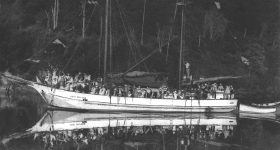Research up the river

River Recreation by the Scowload: The Jane Gifford crowed with Warkworth townspeople enjoying the best available Mahurangi Regatta transport. image Brian Collins Collection
New Zealand River Recreation Use Survey
As oyster farmers, a huge perk of the job was having craft at the ready that were also perfect for recreation.
Visitors to the family at Mahurangi West only had to pass an innocent remark about how beautiful the harbour looked and before they knew it they were part of a full-blown expedition ‘up Dyers Creek’ or ‘up to Warkworth’.
A family friend was first to state ‘the bleedin’ obvious’, that the flat-bottomed oyster punts were the perfect model for a recreation vessel. He had reason to regret that observation later, when we confronted him with the proposal whereby the 33-foot Tigger was built.
At first glance the Tigger looks nothing like an oyster punt, the forward section looking more like a fishing trawler native the owner’s birthplace, Scotland. The spacious bow section provided a veritable dormitory for the family’s five children and their young friends. An extra one or two of the latter could always be found sleeping bag space on the big flat ‘sole’ which was simply two layers of the thickest available construction ply—the vessel’s bottom.
The after part of the vessel was pure oyster punt, spacious and with gunnels sufficiently high for small children to be more-or-less safely corralled.
But she never achieved the carefree workboat aspect the owner admired whereby temporary structures would simply be nailed into place to serve the needs of the current picnic or camping situation. The Tigger succumbed to the yacht-style perfectionism invariably ascendant in the recreational sailor, whereby their craft become as immaculate as a seabird.
During the 1980s, the Tigger had the distinction of being the best-used recreational vessel on the Mahurangi River. Currently she is being readied to return to the water after prolonged shore leave. Her outrageously vibrant colour scheme—reminiscent of a South American admiral’s uniform—has been lovingly and meticulously recreated by a second-generation recreational river user. As a four-year old, we sometimes had him aboard with us, fishing for sprats, while we were sorting oysters—providing some welcome respite for his mother who, with the fisherman’s twin sister, had four under five at that point!
The University of Ōtago’s New Zealand River Recreation Use Survey will, no doubt, net much kayak use. But it will be most interesting to see to what extent more idiosyncratic forms of river craft are captured.
Either way, the survey is a brilliant opportunity to add to the body of science we have already on the Mahurangi. I urge recreational river users to participate in the survey, and to mention it others.
